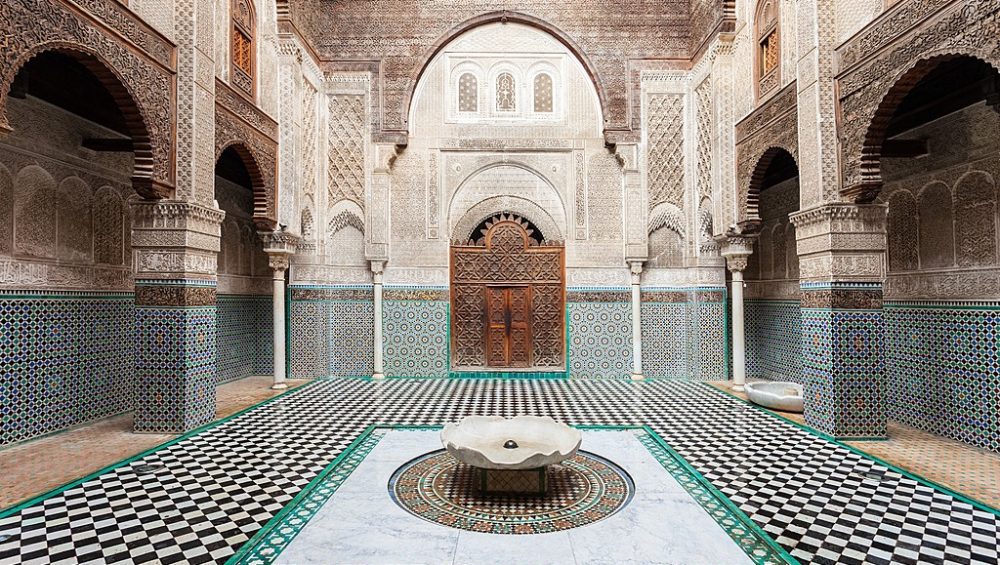Discover Islamic design in Morocco
Islamic geometric design blends elements of mathematics, art and history. During your trip to Morocco, you will see colorful geometric patterns on mosques, madrasas, palaces and private homes. In these settings, beautiful patterns can be found on carpets, zellige tiles, walls, fountains, pillars, doorway trimmings, furniture decorations, ceilings, staircases, hallways, courtyards and gardens.
Many travelers arriving in Morocco admire the abstract designs but wonder about the origins and meaning of Islamic motifs. As a result, we have created a guide to help you understand abstract art and put it into context.
Table of Contents
Past and Present of Islamic Geometric Art
Historically, Islamic patterns emerged around the 7th century, when artisans borrowed motifs from Persian and Roman cultures and adapted them for ornamental decoration in Islamic places of worship. In religious spaces, Islamic art did not depict religious figures as in idolatry, but used shapes and figures in repetitive patterns and calligraphy to inspire prayer. Abstract repetitions became particularly popular during the Islamic Golden Age of the eighth century, a period marked by great achievements in mathematics and science. Sophisticated geometric patterns such as floral and vegetal motifs were seen repeated over and over again on carpets, textiles and patterned tiles.
In the twenty-first century, these patterns have taken on a new lease of life in Moroccan interior decoration. In Moroccan medinas, geometric patterns are found in architectural details, stores and fashion. Riads are renovated and use zellige tiles on stairs, wall fountains, courtyard floors, walls and decorative elements and ceilings are vaulted and covered with cedar.
Tessellation: arrangement of patterns
Many Islamic motifs are arranged in beautiful patterns called tessellations. Three common shapes can form regular mosaics: the equilateral triangle, the square and the regular hexagon. Each of these three shapes can be infinitely duplicated to fill a plane without space. It all starts with a circle that can be drawn with a compass and divided into parts with a ruler. How it is divided, however, will determine the style and design. Most circles are divided into 4,5 or 6 equal sections. Each division styles the pattern. You can determine if the pattern is based on 4, 5 or 6 fold symmetry by finding the star in the center of the tile and counting the number of rays and petals surrounding it. A star surrounded by 6 spokes belongs to the 6-ply category, a star with 8 petals will have 4 spokes and it will belong to the 4-ply category.
Tessellation is based on mathematical elegance. Regardless of their appearance, the designs are always based on hand-drawn grids. Furthermore, Islamic design is based on Greek geometry, which is based on the fundamental belief that complexity can be achieved with simple tools.
[ggiesshortcode]
Beyond Islamic architecture, tessellation can be found in everyday products: oriental rugs, quilts, origami, Islamic architecture, and the works of MC Escher, who created mosaics with irregular tiles in the shape of animals and natural objects.
Islamic patterns and astronomy
An interesting fact that most people overlook when studying Islamic patterns is that there are a multitude of stars. Many scholars of Islamic culture and architecture believe that there is a symbolic connection between the shape of the stars and astronomy. Morocco is a Muslim country with a call to prayer five times a day. It is believed that stars exist to provide direction to Mecca; star gazing acts as a compass. Muslim cultures are also home to nomadic tribes who live in remote mountainous regions and in the Sahara Desert. Navigation by stars therefore has an important skill.
Discover the star patterns: benches, fountains, walls, Moroccan zellige tiles
Another common pattern you will see in Morocco is the zellige tile. Zellige, a glazed terracotta tile made from natural clay from the Fez and Meknes region, is used throughout Morocco. The tiles are revered for their high quality, color and traditional craftsmanship. Historically, zellige first flourished in Andalusia when the Moors invaded parts of southern Spain. Later, the technique was developed under the Nasrid, Marinid and Zayyanid dynasties. The 14th century introduced blue, green and yellow colors to zellige and red was added in the 17th century; ancient glazes in natural colors were used until the early 20th century. Glass enamel tiles are best characterized by variations in tone, gloss, flatness, transparency and depth of glazing. No two tiles are exactly the same. Zellige tiles come in many shapes, sizes and compositions. They are often found in riads, private residences, landscaped benches, fountains, walls or floor installations.
An example of Moroccan architecture and decoration
If you wish to discover the beauty of Moroccan design, we recommend you to spend your stay at the Villa Jardin Nomade: a luxury villa to rent exclusively for your vacations in Morocco. The villa combines modern European architecture and Moroccan decoration to sublimate its guests who become loyal customers thanks to the quality of services that the staff offers them.
And during your stay: do not hesitate to visit the historical monuments of the city to discover the beauty of the Moroccan architecture and decoration.


